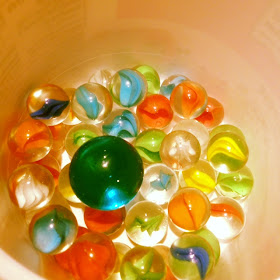No, not the stinging type, the MARBLE type! Those little glass balls that come in
hundreds of different designs and colors. Take a look at the picture. Aren’t
they beauties?
Well, it’s time to knuckle down, because we’ve found
another MUSE!
MARBLES!!!
Kids have been playing MARBLES for hundreds, maybe
even thousands of years. Some people think that cavemen played with marbles
made of clay.
While marbles have also been made of metal and wood,
the most popular marbles are those made of glass.
Take a look at this video and see how marbles are
made. This is SUPER cool!
Most marbles are made in other countries, but one
American company is holding on strong. One
MILLION marbles a day are made at the The Marble King factory in Paden City,
West Virginia. They’ve been making marbles since the 1930’s. Click here and take a look at their website to learn more.
Marble King is also the sponsor of The National
Marble Tournament. This tournament has been held in Wildwood, New Jersey every
summer for over 90 years. Kids from all over the country compete for national
honors, college scholarships, and prizes. Click here to learn more about this tournament.
The most popular marble game is called “Ringer”.
Would you like to learn how to play? If so, take a look at the video.
Something I’m most fascinated with is the different
colors and designs of marbles. And each design has a special name. The Cat’s
Eye is probably the best known marble. But have you heard of Oxbloods, Galaxies,
Tigers, Onionskins, Corkscrews, Rainbows or a Swirly? That’s just the
beginning.
Most marble collectors know exactly what kinds of
marbles they have. First of all, some of them are worth more than others. And
if you are playing “keepsies”, you better know the value of your mibs and
shooters.
 |
| The large marble is the "shooter". |
Oh, you are probably wondering what “mibs” and “shooters”
are. When you play “Ringer”, you shoot your BIG shooter marble at the smaller
target marbles. The target marbles are called “mibs”.
Marbles are often used in other games, too. Have you
ever played Chinese Checkers? What about Hungry Hungry Hippo? Several board games
use marbles as game pieces.
But… Did you know that the little ball that BING-BANGS
inside a spray paint can is also a marble? It sure is!
WARNING: Collect your marbles, play with your
marbles, BUT just don’t LOSE your marbles. (Chuckle)
With this new knowledge, what kind of story could
you write? Maybe these WHAT IF questions will help you get started.
WHAT IF your main character gets lost in a marble
factory?
WHAT IF your main character lost his/her favorite
marble? Did somebody steal it? How much was it worth?
WHAT IF a genie was stuck inside a marble?
The possibilities are endless, and please leave your
own what if questions in the comment section below. I’d love to see what you
come up with.
So, grab a cup of hot cocoa, a pencil and a piece of
paper, and let’s begin. With your imagination, we can go anywhere. I look
forward to seeing where you take us.
With Imagination,
Professor Watermelon
The word of the day is “scholarship”. Here is the
definition: a sum of money or other aid granted to a student,
because of merit, need, etc., to pursue his or her studies.








